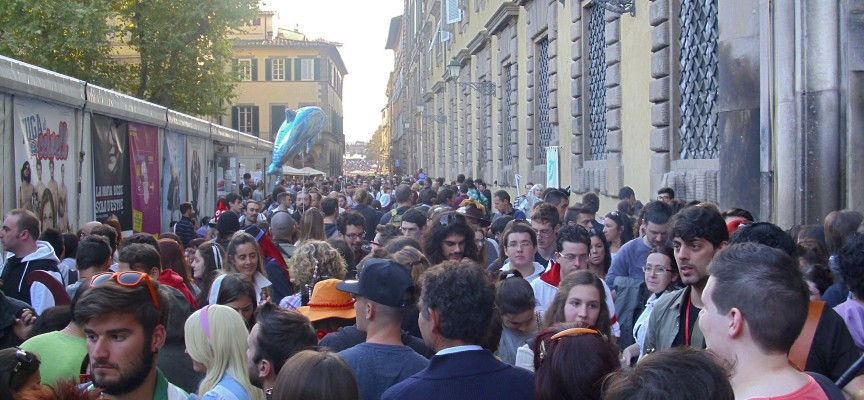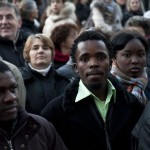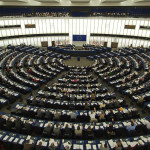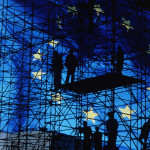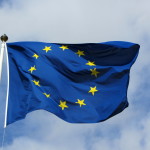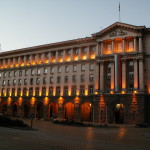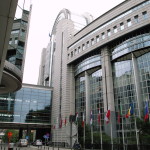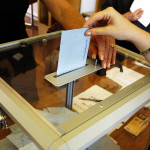The first reflection is about Europe today, the one in front of which we would like to imagine a different Europe. Today’s Europe, in fact, often flounders like a fish in a puddle. It flaps its fins, moves about nervously to become more visible, but does not make much progress, it remains imprisoned in the small puddle, increasingly feeble. This is especially palpable in the moments of international tension, when we would rather need a Europe capable of effective initiatives, united, and authoritative. This Europe, instead, gets lost in the midst of the self-promoting attitude of many leaders, maybe because of the objective shortcomings of an institutional mechanism which still cannot implement the dynamics that should be typical of a genuine Union of States. This made somebody say that this Europe is unified, yes, but not yet united. Again, today’s Europe, on the gridiron of an unprecedented economic and social crisis, is gradually losing the motivations and enthusiasm which are at the very root of the European project. Flustered on a currency which is being debated for seven days every week, and set against the ghost of national debt and the deficit-GDP ratio. These are all indisputable issues, but maybe they became too awkward, with the risk of suffocating any other tension.
We could go ahead for ever, but it is worthwhile casting a glance at the “other” Europe whose dream, we still think, could come true. A set of countries and peoples which had placed at the root of their unity-building process not only the economic issues, but even more their thirst for peace and cooperation, in view of a shared well-being that would enable to leave behind once and for all the tragic experiences of the 20th century. A set of countries and peoples searching for integration, dialogue, and inclusion – using a word which is much cherished by the European institutions. Where the different cultures and religions – not to be forgotten – could interweave in a virtuous mechanism of growth and human and social promotion.
Is this only a dream? Certainly not. If the political and administrative embodiment has not always been up to the task, nonetheless there are today many signs of the fact that the aspiration to a Europe united in its diversity still resists. There is an ongoing flow of exchanges, conversations, interconnections involving people and institutions which feeds with constantly fresh water the rivers of Europe and even gets to the Parliament in Brussels, after having crossed all the Countries and the squares of the Continent. We shall better look at these rivers, not only at the puddle.
La prima riguarda l’Europa di oggi, quella rispetto alla quale vorremmo immaginarne un’altra. Un’Europa, quella di oggi, che si dibatte spesso come un pesce in una pozzanghera. Sbatte le pinne, si agita, per far vedere che c’è, ma fa poca strada, resta prigioniera, appunto, della piccola pozza, sempre più asfittica. Sembra di vedere questo soprattutto nei momenti di tensione internazionale, quando invece servirebbe un’Europa capace di iniziativa efficace, unita, autorevole. Quella che si perde tra i protagonismi di vari leader, forse per le carenze oggettive di un meccanismo istituzionale che ancora non realizza le dinamiche proprie di una Unione autentica di Stati. Cosa che fa dire a qualcuno di come l’Europa di oggi sia sì unificata, ma non ancora unita. Un’Europa, ancora quella di oggi, che sulla graticola di una crisi economica e sociale forse senza precedenti è andata perdendo motivazioni ed entusiasmi che sono invece all’origine del progetto europeo. Incartata su una moneta che viene discussa un giorno sì e l’altro pure, sullo spettro dei debiti nazionali e del rapporto deficit-pil. Tutte questioni sacrosante, ma forse diventate un po’ troppo ingombranti, col rischio di soffocare ogni altra tensione.
Si potrebbe andare avanti, ma vale la pena di guardare un momento all’“altra” Europa che continuiamo a sognare possibile. Un insieme di Paesi e di popoli che alla radice del processo unitario aveva messo non solo le questioni economiche, ma più ancora l’aspirazione alla pace e alla cooperazione, in vista di un benessere condiviso che permettesse di lasciare alle spalle, definitivamente, esperienze tragiche come quelle vissute nel Novecento. Un insieme di Paesi e di popoli alla ricerca d’integrazione e dialogo, d’inclusione, per usare un termine caro alle istituzioni europee. Dove le culture e le religioni diverse – ci sono anche loro – potessero intrecciarsi in un meccanismo virtuoso di crescita e promozione umana e sociale.
Solo un sogno? Sicuramente no. Se la traduzione politica e amministrativa non è stata sempre all’altezza, tuttavia ci sono anche oggi tanti segnali di come l’aspirazione a un’Europa unita nelle diversità continui a resistere. Esiste un flusso continuo di scambi, dialoghi, intrecci tra persone e istituzioni che alimenta con acqua sempre nuova i fiumi dell’Europa e che arriva anche nelle aule del Parlamento di Bruxelles, passando attraverso i Paesi e le piazze del Continente. Conviene guardare a questi fiumi, non solo alla pozzanghera.
Alberto Campoleoni
Latest posts by Alberto Campoleoni (see all)
- The rivers and the puddle - 4 aprile 2014

